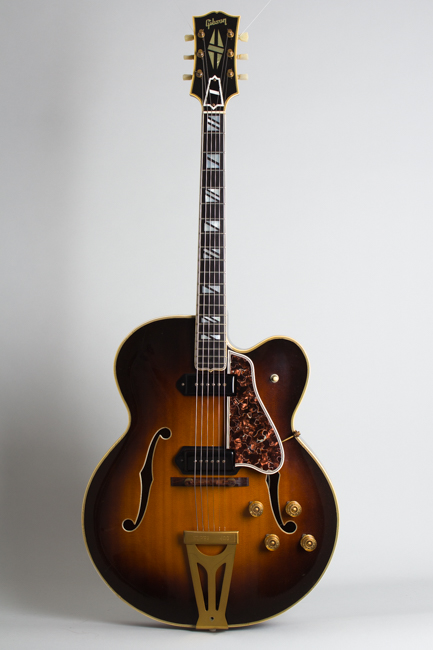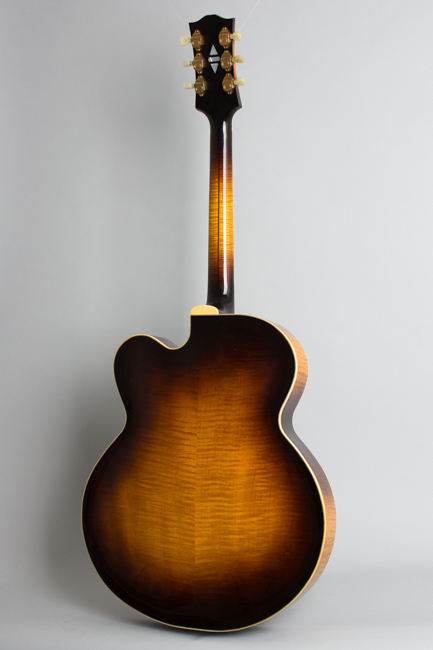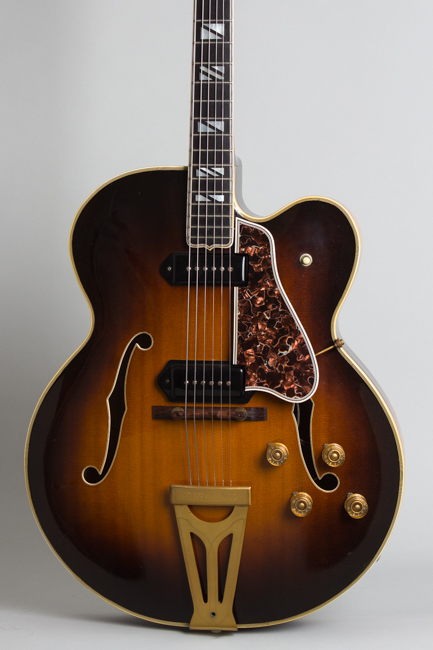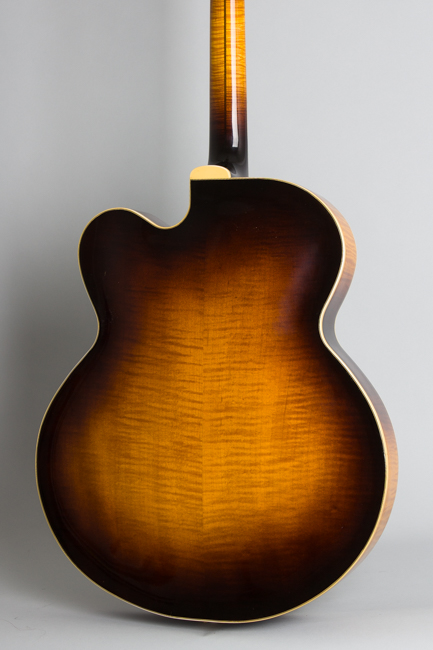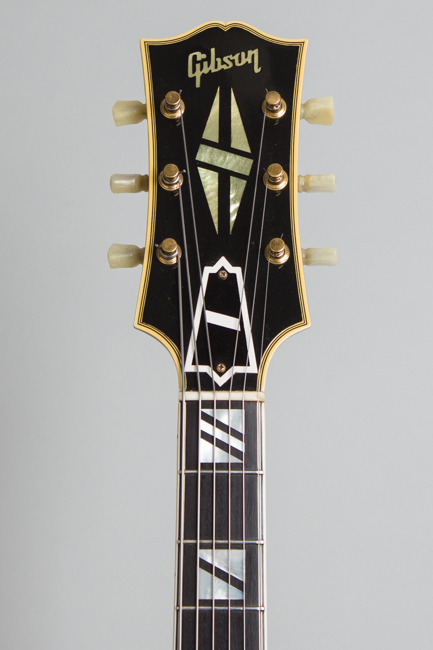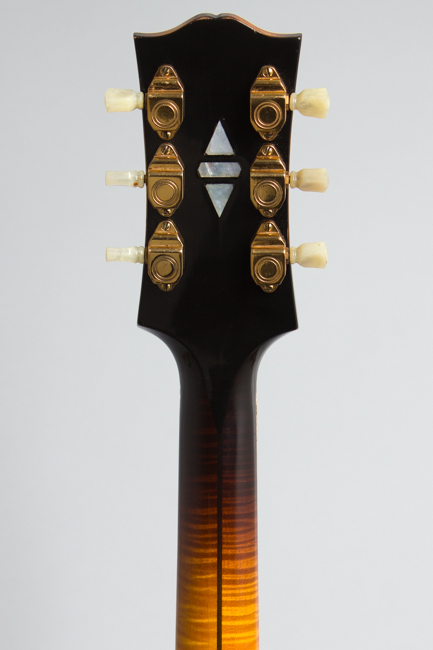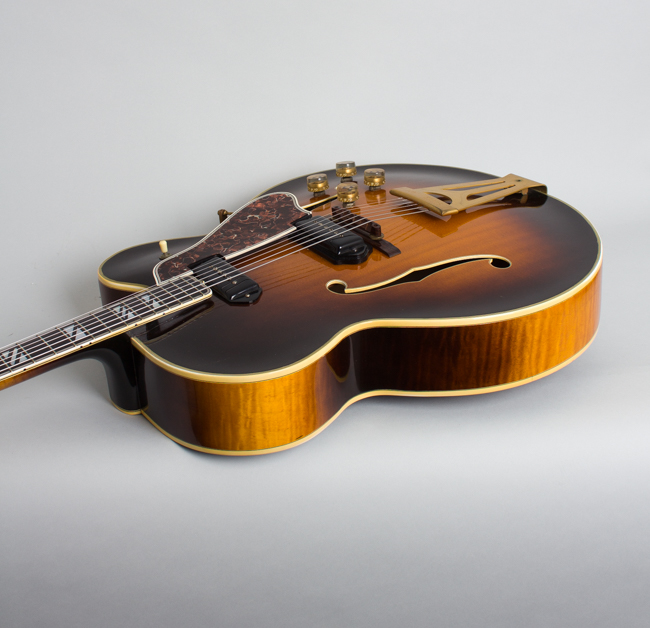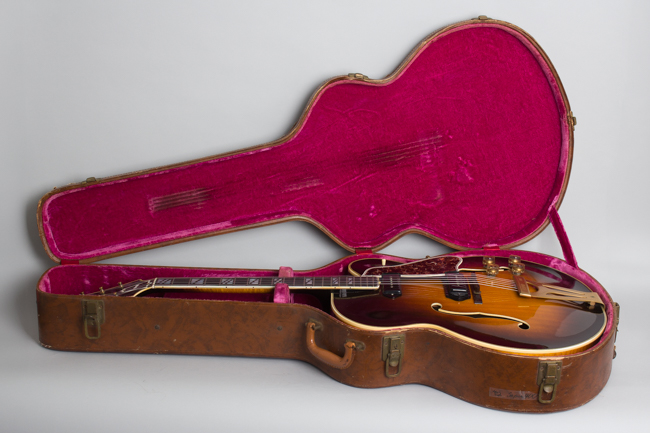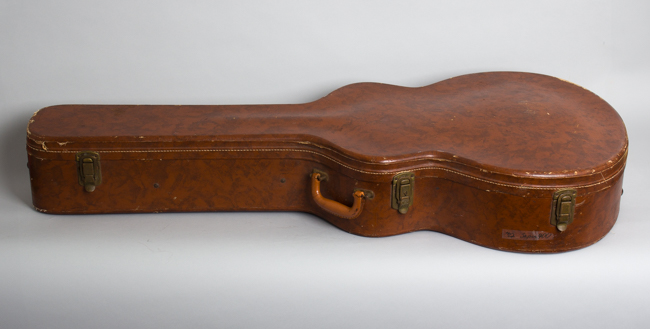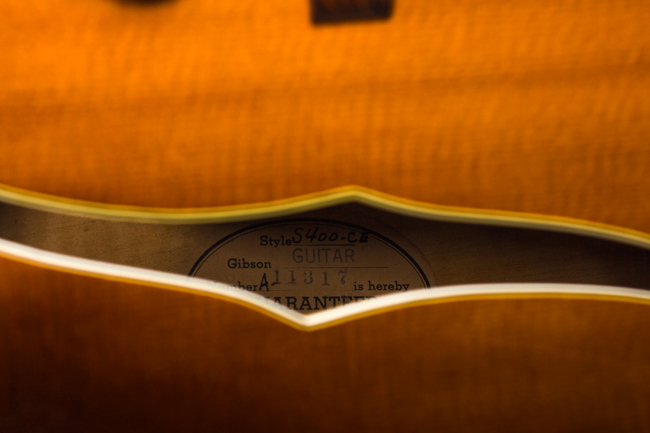Gibson Super 400 CES Arch Top Hollow Body Electric Guitar (1952)
Gibson Super 400 CES Model Arch Top Hollow Body Electric Guitar (1952), made in Kalamazoo, Michigan, serial # A-11317, sunburst lacquer finish, maple back and sides, spruce top; laminated maple neck with ebony fingerboard, original brown hard shell case.
Gibson's top-of-the-line classiest electric guitar, the large-bodied Super 400 CES (Cutaway Electric Spanish) has been a company mainstay for decades and a favorite of many classic jazz and R&B players. This rare example is one of the VERY first ones ever made, the earliest version with P-90 pickups and the rounded cutaway used from its introduction in 1951. An A-series serial number on the label inside dates this guitar's shipment to late July 1952; it also notes the model as "Super 400CE".
With all the features of an acoustic Super 400 and two built in pickups, this was a guitar worthy of Gibson's top endorsers. Built with all solid woods including a fully carved top and back, the Super 400 CES was aimed squarely at the top of the market, the fanciest and most expensive electric guitar yet made in 1951. Gibson's March 1952 price list offered the sunburst model at $595 plus $60 for the case, a whopping price for an electric guitar at the time and an indicator of how purely amplified instruments had gained full professional acceptance by that time. By March 1953 that had jumped dramatically to $715; a gold-topped Les Paul could be had for $250.
So what did the ambitious player of 1952 get for all that cash? Gibson went all out to make this most prestigious instrument, impressive to both the player AND the audience; in both looks and sound this was the benchmark of all period arch-tops. This supremely classy example has the earliest features of the model: The 2-piece back is solid carved flame maple, the top is solid carved spruce. The laminated maple neck has the fairly chunky round-backed profile typical of the early 1950's. The finish is a blended fairly dark sunburst overall. There is multiple binding everywhere; the ebony fingerboard and headstock overlay have bold Deco-styled split block pearl inlay.
All hardware is of course gold plated. The two original P-90 pickups are mated to the then-new (introduced with this model) Gibson 4-knob, 1 switch wiring rig. The pots are topped off with the tall numbered gold-backed clear plastic knobs typical of the earlier '50s. The engraved gold-plated tailpiece has "Super 400" on the crossbar and the old "top-buster" tension adjustment that (thankfully!) almost nobody ever used, mated to the standard adjustable rosewood bridge. The tuners are Kluson Sealfast enclosed machines with single-ring plastic "Keystone" buttons. The truss rod cover is the unique wide-bevel piece used on Super 400s since the 1930s, while the multi-bound elevated pickguard is the unique mottled celluloid usually reserved for Super 400s.
This is a very rare guitar; all of 7 sunburst examples were registered in 1952, after 2 shipped in 1950 meaning this is one of the first 10 sunburst CES models ever made. These numbers represent a miniscule fraction of the totals for other period Gibson instruments. According to most calculations, only around 50 or so Super 400 CES models were ever built with P-90 pickups in any finish before the model switched to Alnico staple-magnet and then PAF humbucking pickups.
The Super 400 CES was an instrument for the top professional player, and is considered one of the seminal jazz and R&B guitars. Various iterations have been used by many greats in the 1950s and beyond from Scotty Moore and Joe Maphis to jazzers including Kenny Burrell, George Benson, Eric Gale, Robben Ford and Larry Coryell. This first-generation example is a very rare find, especially in this spectacular all-original condition. It is simply a superb instrument in every way!
Overall length is 44 1/4 in. (112.4 cm.), 18 in. (45.7 cm.) wide at lower bout, and 3 5/16 in. (8.4 cm.) in depth, measured at side of rim. Scale length is 25 1/4 in. (641 mm.). Width of nut is 1 11/16 in. (43 mm.).
This guitar shows very few signs of use over the past 70+ years with only the most superficial wear, remaining structurally excellent and a very fine player. The original finish over the entire instrument shows hardly any checking and just some scattered very small dings, dents and scratches. The back of the neck is extremely clean, looking hardly used. There are no apparent cracks or structural repairs to the instrument.
The guitar remains original including the often-problematic celluloid pickguard, which has no signs of outgassing. Even the gold plating shows only very minor wear. The ivory plastic switch tip is not the standard piece used later but appears original, or at least period. The original frets have some very light wear but still play well.
This is a truly superb instrument in every way, not only the finest early Super 400 we have ever seen but one of the best preserved Gibsons of any style from this era we have had. It offers a particularly cool set of features specific to the 1951-54 era; there were only a very limited number of this model built to this exact spec. If a "first generation" Super 400 with P-90s is your bag this is IT. It still resides in its original pink plush lined brown HSC showing some external wear but completely solid. Overall Excellent + Condition.
Gibson's top-of-the-line classiest electric guitar, the large-bodied Super 400 CES (Cutaway Electric Spanish) has been a company mainstay for decades and a favorite of many classic jazz and R&B players. This rare example is one of the VERY first ones ever made, the earliest version with P-90 pickups and the rounded cutaway used from its introduction in 1951. An A-series serial number on the label inside dates this guitar's shipment to late July 1952; it also notes the model as "Super 400CE".
With all the features of an acoustic Super 400 and two built in pickups, this was a guitar worthy of Gibson's top endorsers. Built with all solid woods including a fully carved top and back, the Super 400 CES was aimed squarely at the top of the market, the fanciest and most expensive electric guitar yet made in 1951. Gibson's March 1952 price list offered the sunburst model at $595 plus $60 for the case, a whopping price for an electric guitar at the time and an indicator of how purely amplified instruments had gained full professional acceptance by that time. By March 1953 that had jumped dramatically to $715; a gold-topped Les Paul could be had for $250.
So what did the ambitious player of 1952 get for all that cash? Gibson went all out to make this most prestigious instrument, impressive to both the player AND the audience; in both looks and sound this was the benchmark of all period arch-tops. This supremely classy example has the earliest features of the model: The 2-piece back is solid carved flame maple, the top is solid carved spruce. The laminated maple neck has the fairly chunky round-backed profile typical of the early 1950's. The finish is a blended fairly dark sunburst overall. There is multiple binding everywhere; the ebony fingerboard and headstock overlay have bold Deco-styled split block pearl inlay.
All hardware is of course gold plated. The two original P-90 pickups are mated to the then-new (introduced with this model) Gibson 4-knob, 1 switch wiring rig. The pots are topped off with the tall numbered gold-backed clear plastic knobs typical of the earlier '50s. The engraved gold-plated tailpiece has "Super 400" on the crossbar and the old "top-buster" tension adjustment that (thankfully!) almost nobody ever used, mated to the standard adjustable rosewood bridge. The tuners are Kluson Sealfast enclosed machines with single-ring plastic "Keystone" buttons. The truss rod cover is the unique wide-bevel piece used on Super 400s since the 1930s, while the multi-bound elevated pickguard is the unique mottled celluloid usually reserved for Super 400s.
This is a very rare guitar; all of 7 sunburst examples were registered in 1952, after 2 shipped in 1950 meaning this is one of the first 10 sunburst CES models ever made. These numbers represent a miniscule fraction of the totals for other period Gibson instruments. According to most calculations, only around 50 or so Super 400 CES models were ever built with P-90 pickups in any finish before the model switched to Alnico staple-magnet and then PAF humbucking pickups.
The Super 400 CES was an instrument for the top professional player, and is considered one of the seminal jazz and R&B guitars. Various iterations have been used by many greats in the 1950s and beyond from Scotty Moore and Joe Maphis to jazzers including Kenny Burrell, George Benson, Eric Gale, Robben Ford and Larry Coryell. This first-generation example is a very rare find, especially in this spectacular all-original condition. It is simply a superb instrument in every way!
Overall length is 44 1/4 in. (112.4 cm.), 18 in. (45.7 cm.) wide at lower bout, and 3 5/16 in. (8.4 cm.) in depth, measured at side of rim. Scale length is 25 1/4 in. (641 mm.). Width of nut is 1 11/16 in. (43 mm.).
This guitar shows very few signs of use over the past 70+ years with only the most superficial wear, remaining structurally excellent and a very fine player. The original finish over the entire instrument shows hardly any checking and just some scattered very small dings, dents and scratches. The back of the neck is extremely clean, looking hardly used. There are no apparent cracks or structural repairs to the instrument.
The guitar remains original including the often-problematic celluloid pickguard, which has no signs of outgassing. Even the gold plating shows only very minor wear. The ivory plastic switch tip is not the standard piece used later but appears original, or at least period. The original frets have some very light wear but still play well.
This is a truly superb instrument in every way, not only the finest early Super 400 we have ever seen but one of the best preserved Gibsons of any style from this era we have had. It offers a particularly cool set of features specific to the 1951-54 era; there were only a very limited number of this model built to this exact spec. If a "first generation" Super 400 with P-90s is your bag this is IT. It still resides in its original pink plush lined brown HSC showing some external wear but completely solid. Overall Excellent + Condition.
